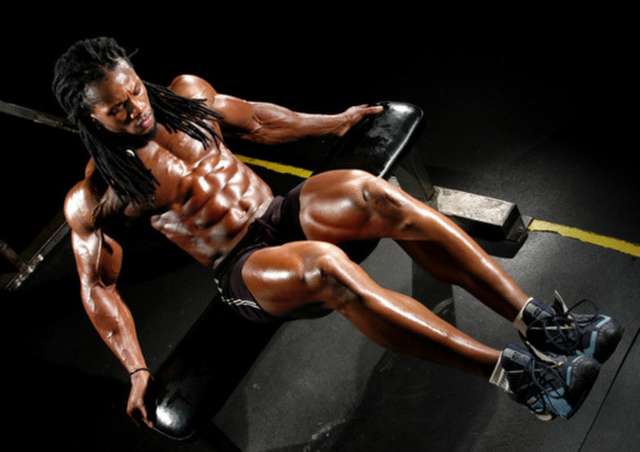Top 4 ways the mind can influence your muscle growth
I don’t want you to get the wrong impression here. Just thinking about something doesn’t manifest itself into a physical object, especially when building muscle. Work must be put in to build up progress in some tangible form.
From the title of this article though, you can probably tell that there will be some information that can be used for your benefit; Right here, right now, today. I want to dive deep into a subject that doesn’t really get much attention aside from watching bodybuilding motivational videos before a workout.
It may sound somewhat complicated, but believe me, it really isn’t.
I want to dissect the mind completely from a physical standpoint and an emotional standpoint that will leave you feeling more pumped and excited than you’ve ever been to step foot in the gym and annihilate the weights.
“…Even perfect nutrition and training will only get you so far. The rest is made up with the mind.”
Many times the mind will get shoved aside by the bigger bullies of bodybuilding today. At the front of the pack you have your nutrition, which is the clear foundation of any noticeable physique. Next is your training. Everything from intensity, duration, sets, reps, rest periods, tempo and technique are used to maximally help increase your muscle size. This is like a broken record. We’ve all heard this stuff on repeat.
If you’ve been lifting consistently and have experienced the great benefits of strength and muscular adaptation, then you probably already know what works best for you. But I’m here to tell you today that even perfect nutrition and training will only get you so far. The rest is made up with the mind.
Before we dive into the pool of your muscle-building potential though, I want to emphasize that even if you think you’ve reached your limit with muscle gains and you’ve absolutely used all of your available resources, then think again! This is not the time to be held back by limiting beliefs.
If you are truly serious about your results in and out of the gym, you need to first come to terms with your physical mind. Let’s get after it shall we?
Neuromuscular Shaping
I’m guessing you haven’t heard of this term before. Put simply, it just means that the mind and the working muscle need to develop a better relationship to perform optimally. It is your goal as a bodybuilder to “shape” your muscles into whatever you want them to look like. Traditionally, this just meant training that muscle a bit more or tweaking your diet to increase growth.
Now, that’s only part of the equation. You’re missing a huge piece of the muscle-building pie my friend! You’ve done more exercises, you’ve increased the resistance, you’ve changed your routine, but when was the last time you mentally recruited more muscle fibers?
This isn’t a simple question to answer, so I’ll have you figure it out for yourself. Here’s an analogy I like to use a lot when referring to neuromuscular shaping:
Suppose your goal is to climb a mountain that you’ve never climbed before. In fact, neither has anyone else. There are no trails or easy ways to the top. Your only option is to forge your own path until you reach the peak. The first trip is the hardest, and takes a long time to finally reach your destination, but somehow you get there. It’s a long walk back down but you try to follow the same path that you took.
So now that you’ve climbed it once, do you think it would be easier to climb it a second time? After all, you made your own trail in the first round. All you have to do is trace your steps back up the mountain again, right?
Let’s suppose that you did this same routine every day for a year, or 5 years, or even 10 years? How do you think your trail would look after all that? I’d say it would be pretty easy to get to the top with a clear trail to navigate, wouldn’t you?
You see, we are trying to shape and direct the neuromuscular pathways to your muscles. In order for a muscle to contract, it must first receive a signal from the brain to do so. When this same signal is repeatedly sent back and forth between the mind and muscle over time (climbing the mountain), MORE neuromuscular pathways are created to enhance the strength of the contraction. It’s safe to say that this is an exciting piece of information to have, especially when your main goal is to add some serious mass to your frame!
I want you to practice some of this “mind-muscle” connection on yourself…
From a sitting position on your chair or bench that you’re on right now, try to mindfully contract your hamstring on the right side WITHOUT contracting the quadriceps. Be sure to place one of your hands on top of the quad to make sure it doesn’t move.
How did it go? Did it work?
More often than not, if the hamstrings aren’t developed correctly, the signal from your brain will make its way down your leg but will not have a CLEAR path to dictate what muscle should contract; therefore the signal is sent to the stronger muscle of the two, the quadriceps!
Now try repeating this signal over and over again to the same right hamstring, and see what happens…
Are you able to contract it without the quadriceps moving? It’s funny how this system works and it really makes all the difference with how much muscle is stimulated during exercise. This same concept can be applied to every major muscle of the body.
Once a thorough neuromuscular connection has been established to your major muscles, it’s time to put them to the test.
Imagery
This concept can be extremely profound and powerful when done correctly. The best part is that research even backs it up; mentally performing an exercise in your mind will directly enhance how much power output your body produces once performed in real life.
When I learned this concept for the first time, it was like I struck pure gold. I was doing what no one else was doing and I was getting better results because of it. Here’s some research from a blog of the muscle-building master himself, Charles Poliquin:
“For example, one study had novice weightlifters imagine that they were performing a bicep curl exercise three times a week for eight weeks. The participants did not actually do any bicep curls or any other elbow flexion training during that time. However, they still gained strength in both the elbow flexors and extensors (44 and 32 percent increase in strength, respectively). A second study found that college athletes who performed visualization before strength training had more confidence and lifted more weight in a leg press exercise than they had done before without imagery.”
I’d say this is a pretty significant piece to your muscle-building puzzle. From an application standpoint during your training and even before your training, try these techniques:
- Use internal imagery to practice your main core lifts in your mind before you even set foot in the gym. Using a bench press as an example, this would involve you thinking about loading up the bar with new weight, sitting down on the bench, getting your back position down into the pad, getting a perfect grip on the bar, lifting it, and performing every single rep in your mind as clear as you possibly can – feeling your chest contract and release each time.
- Use external imagery to imagine watching yourself perform this same movement but from a spotters position or a coaches position. Having a birds-eye-view can give extra motivation and willpower to complete the set from a different point of view.
Having a Compelling Purpose
Here’s a question for you:
What is your reason to build muscle? More specifically, what is your purpose for working so hard in and out of the gym? Someone with a weak mental capacity would answer this question by saying, “I want to build more muscle and get ripped.”
Dig deeper guys!
You want to build muscle because…?
There is ALWAYS an underlying reason that you do the things that you do. For me, my reasons are a few things: I lift to release aggression (my form of therapy), I lift to feel more dominant when around other males, and more importantly, I lift because it is my passion – the feeling, the sacrifice and all the rewards that come with it.
From my example you should be able to figure out what your own “purpose” is for wanting to build muscle. If you don’t’ have a clear purpose then you are only walking blindly towards your cherished finish line.
“Purpose has a direct correlation with motivation. A lack of motivation will always point back to an unclear or unsatisfied purpose.”
Once your reasons are made clear for building up some serious mass, it’s time to tap into the best part of the mental picture…unleashing your inner BEAST!
 I Am Powerful Beyond Measure
I Am Powerful Beyond Measure
I want you to adopt this mindset right now. You’ve already proven yourself by making it this far, you’ve shown that you truly want more muscle, so go get it!
It is during this mindset “phase” that the true “you” comes out. There’s no time to mess around anymore.
When you reach inside and are able to harness the most powerful part of yourself, your potential to build real muscle becomes unlimited. To get to this mental state, it requires complete concentration on the task at hand. Whatever it takes to block out the distractions of the gym atmosphere, then I advise you to do it.
I haven’t known many guys that have the ability to reach this “monk-like” state when working out. However, this doesn’t mean that you can’t do it yourself.
And the best part?
This process is entirely up to you. If praying or meditation works to block out the world then do that. If you need loud music in your ears then listen to that to get you amped up.
The only way that I can truly describe this “state” is being in a completely different world once the headphones go in. My mind tells me I am powerful beyond measure before I even pick up a weight.
Don’t make the mistake of being inconsistent. The more you practice this principle day-in and day-out, the easier it will be to control the amount of generated power produced.
Conclusion
The mind has always been at the core of building muscle. Most often than not though, the importance of having a strong mind is overshadowed by being strong physically. Sure, there is a genetic potential about how much muscle you can build naturally, but I doubt that you’ve hit that point yet. If you’ve truly accepted that you’ve tried everything in order to build new mass then that’s your opinion. But for those of you who are willing to strengthen up your mind today, you will undoubtedly see the amazing muscle-building potential that you can reach for tomorrow.
-Mitch Muller
(Your Mindset and Muscle Coach)
Sources: Poliquin, Charles (Oct 2012) “Tip 459: Use Mental Imagery Before Workouts To Improve Performance.”http://www.charlespoliquin.com/Blog/tabid/130/EntryId/1623/Tip-459-Use-Mental-Imagery-Before-Workouts-To-Improve-Performance.aspx




 I Am Powerful Beyond Measure
I Am Powerful Beyond Measure Top 5 Myths About Fitness Exercises
Top 5 Myths About Fitness Exercises